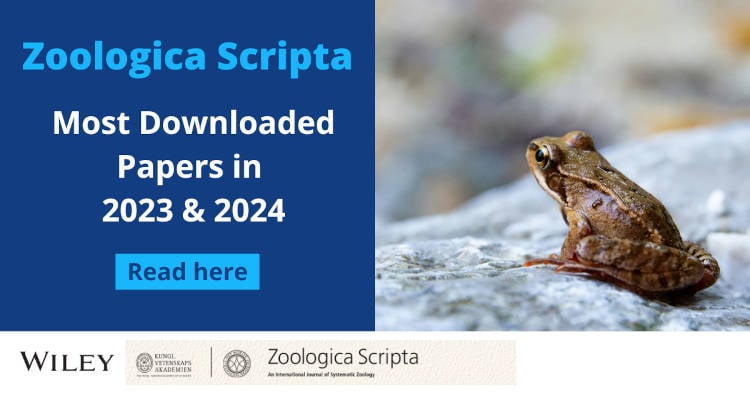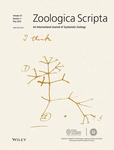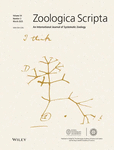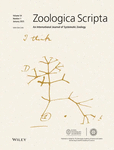Edited by: Lutz Bachmann
The Zoologica Scripta – An International Journal of Systematic Zoology publishes papers of interest to all researchers in animal systematics and phylogeny.
Our research includes animal systematics in a phylogenetic, phylogeographic, or ecological context. Our articles delve deep to get answers; purely taxonomic papers are not considered for publication. We are published on behalf of the Norwegian Academy of Science and Letters and the Royal Swedish Academy of Sciences.
Journal Metrics
- 4.7CiteScore
- 2Journal Impact Factor
- 37%Acceptance rate
- 29 days Submission to first decision
Articles
Evolutionary Relationships Among the Amazonian Catfish Genus Hypophthalmus Cuvier, 1829 (Siluriformes, Pimelodidae) Suggest Diversification During Plio-Pleistocene
- 22 July 2025
Historical Fragmentation in Atlantic Forest Explains the Diversification of a Clade of Mountaintop Bromeligenous Frogs (Leptodactylidae: Crossodactylodes)
- 11 July 2025
Molecular Phylogeny of Mouse‐Tailed Bats (Chiroptera: Rhinopomatidae): Evolutionary Insights Into a Desert‐Dwelling Family
- 7 July 2025
The New Old Rat (Rattus, Mammalia) From Turkestan: Revisiting From a Genomics Perspective
- 2 July 2025
The following is a list of the most cited articles based on citations published in the last three years, according to CrossRef.
Molecular insights into the phylogenetic structure of the spider genus Theridion (Araneae, Theridiidae) and the origin of the Hawaiian Theridion-like fauna
- 337-352
- 10 May 2007
Mecoptera is paraphyletic: multiple genes and phylogeny of Mecoptera and Siphonaptera
- 93-104
- 8 April 2002
Phylogeny and the evolution of acoustic communication in extant Ensifera (Insecta, Orthoptera)
- 525-561
- 17 October 2003
The potential and pitfalls of de‐extinction
- Zoologica Scripta
- 22-36
- 27 September 2016
A new antshrike (Aves: Thamnophilidae) endemic to the Caatinga and the role of climate oscillations and drainage shift in shaping cryptic diversity of Neotropical seasonal dry forests
- Zoologica Scripta
- 487-508
- 17 June 2024
Systematics and evolutionary history of raft and nursery‐web spiders (Araneae: Dolomedidae and Pisauridae)
- Zoologica Scripta
- 421-435
- 3 February 2025
A renaissance of microRNAs as taxonomic and phylogenetic markers in animals
- Zoologica Scripta
- 754-762
- 21 June 2024
Molecular phylogenetics of the superfamily Stromboidea (Caenogastropoda): New insights from increased taxon sampling
- Zoologica Scripta
- 818-838
- 4 July 2024
Form, function and phylogeny: comparative morphometrics of Lake Tanganyika's cichlid tribe Tropheini
- Zoologica Scripta
- 362-373
- 10.1111/zsc.12110
Volume 54, Issue 4 (June 2025)
Molecular phylogeny of the operculated land snail family Pupinidae (Caenogastropoda, Cyclophoroidea) in mainland Southeast Asia
- Zoologica Scripta
- 526-547
- 10.1111/zsc.12727
Abstract
The operculated land snail family Pupinidae from mainland Southeast Asia has been systematically revised based on shell morphology. Despite previous morphological studies, the evolutionary relationships within this family remained unclear. This study represents the first comprehensive molecular phylogeny of this snail group, utilising two mitochondrial (COI and 16S rRNA) and two nuclear (5.8S rRNA + ITS2 and 28S rRNA) genetic markers. Additionally, we conducted phylogenetic analyses of Pupina species from 1106 loci generated through double-digest restriction site-associated DNA sequencing (ddRADseq). It turned out that Southeast Asian Pollicaria emerged as a sister clade to Central American Aperostoma of the Megalomastomatidae, leading to the resurrection of the Pollicariidae. Among the remaining pupinid genera, Tortulosa was nested within the Coptocheilus clade, while Pupina and Pupinella were not monophyletic. The previously recognised Pupina arula species group was found to be monophyletic and was reclassified into Tylotoechus (formerly a Pupina subgenus), based on distinctive conchological characters such as an extending parietal tooth from a parietal callus and a wide, outward-curving posterior canal. However, some Pupina and Tylotoechus species were not retrieved as monophyletic, suggesting the presence of multiple ‘cryptic species’. Divergence time estimation indicated that the Pupinidae split could date back to the Late Triassic to Early Cretaceous, with the first diversification of pupinid genera occurring during the Middle Jurassic and Early Cretaceous. This successful reconstruction of a robust phylogeny using ddRADseq loci demonstrates the significant potential of RADseq techniques in elucidating the evolutionary relationships of deeply divergent taxa. Further studies incorporating the type species Tylotoechus destructus and Pupina keraudrenii are necessary to justify the usage of these genera.
Volume 54, Issue 3 (May 2025)
Tempo and mode of diversification of the red devil spiders (Araneae: Dysderidae) of the Canary Islands
- Zoologica Scripta
- 406-420
- 10.1111/zsc.12710
Abstract
The study of adaptive radiations has shed light on our current understanding of evolution. However, previous studies examining the mode in which species diversified, how diversification rates varied, and how ecological specialisation affected these processes have found few different results across different taxa and geographic and ecological systems, showing how complex this process is. To gain a more complete picture of how species evolve, additional model systems that encompass alternative ecological requirements are needed. Here, we present the results of a study aimed at unravelling the diversification mode and evolutionary drivers of the spider genus Dysdera, the red devil spiders, endemic to the Canary Islands. These species exhibit remarkable phenotypic variability in their mouthparts, which has been related to different levels of specialisation in the predation of isopods. We explored patterns of lineage diversification and assessed the role of trophic specialisation as a driver of species diversification. Additionally, we used climatic variables, occurrence data and morphological information to unravel the underlying mode of speciation by means of joint species distribution models and age-range correlation methods. Our results reveal that red devil spiders underwent an early burst of diversification, followed by a slowdown of diversification rates, which is a hallmark of adaptive radiation. We also found evidence that the trophic morphology shaped diversification, with specialist species exhibiting higher rates of diversification. Finally, our analyses suggest that speciation occurred mostly in allopatry, with subsequent secondary sympatry following range expansion.










